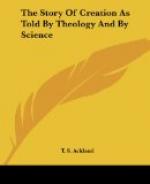The next act recorded is, that “God divided the light from the darkness.” This is one of those passages which we are very apt to pass over as unimportant, without giving ourselves any trouble to ascertain what they mean, or asking if they may not give valuable information, or supply some important hints. It is evident, however, that in these words some act of the Creator is implied, but when we inquire what that act was, the answer does not lie immediately on the surface. Darkness is simply the absence of light. It cannot therefore be said that God divided the light from the darkness in the same sense in which it is said that “a shepherd divideth his sheep from the goats”. Between light and darkness that division exists in the very nature of things, and it could not therefore be said to be made by a definite act. Nor again, is there any sharp well-defined boundary set between light and darkness, so that we can say, “Here light begins, here darkness ends.” The very opposite is the case, the one blends imperceptibly into the other. This then cannot be the meaning of the words. But the next verse guides us to the real meaning. “And God called the light Day, and the darkness He called Night.” The division of light from darkness then is the alternation of night and day. When God divided the light from the darkness He made provision for that alternation. But we know that that alternation is the result of the earth’s rotation upon its axis, so that the dividing the light from the darkness evidently implies the communication to the accumulated mass of the motion of rotation.
It does not clearly appear in the account of the first day, whether this alternation of day and night took effect immediately. Certainly the introduction of it here does not prove that it did so follow. For there was no way in which the fact of the earth’s rotation could be directly communicated to those for whom the narrative was primarily intended. They were ignorant of the spherical form of the earth, and so could not have attached any idea whatever to a statement that it revolved about its axis.
The only way then in which Moses could speak of that rotation was in connexion with some phenomenon resulting from it. The only such phenomenon with which the Jews were acquainted was the alternation of day and night. There was therefore no way in which Moses could record the fact except with reference to this ultimate effect. It does not follow that that effect was immediate. Beside the rotation of the earth, another condition is required. The light must come from a single source, and so when the act is recorded by which that condition is effected, the division of light and darkness is again noticed. The sun and the moon are set in the firmament of heaven to divide the light from the darkness. But that division was potentially effected when the motion of rotation was given.




